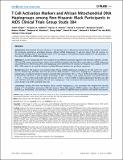T Cell Activation Markers and African Mitochondrial DNA Haplogroups among Non-Hispanic Black Participants in AIDS Clinical Trials Group Study 384

View/
Author
Hulgan, Todd
Kalams, Spyros A.
Samuels, David C.
Grady, Benjamin
Shafer, Robert
Murdock, Deborah G.
Selph, Doug
Haas, David W.
Pollard, Richard B.
Published Version
https://doi.org/10.1371/journal.pone.0043803Metadata
Show full item recordCitation
Hulgan, Todd, Gregory K. Robbins, Spyros A. Kalams, David C. Samuels, Benjamin Grady, Robert Shafer, Deborah G. Murdock, Doug Selph, David W. Haas, and Richard B. Pollard. 2012. T cell activation markers and African mitochondrial DNA haplogroups among non-Hispanic black participants in AIDS Clinical Trials Group Study 384. PLoS ONE 7(8): e43803.Abstract
Introduction: Mitochondrial function influences T cell dynamics and is affected by mitochondrial DNA (mtDNA) variation. We previously reported an association between African mtDNA haplogroup L2 and less robust CD4 cell recovery on antiretroviral therapy (ART) in non-Hispanic black ACTG 384 subjects. We explored whether additional T cell parameters in this cohort differed by mtDNA haplogroup. Methods: ACTG 384 randomized ART-naïve subjects to two different nucleoside regimens with efavirenz, nelfinavir, or both. CD4 and CD8 memory and activation markers were available at baseline and week 48 on most subjects. mtDNA sequencing was performed on whole blood DNA, and haplogroups were determined. We studied non-Hispanic black subjects with HIV RNA <400 copies/mL at week 48. Analyses included Wilcoxon ranksum test and linear regression. Results: Data from 104 subjects were included. Major African mtDNA haplogroups included L1 (N = 25), L2 (N = 31), and L3 (N = 32). Baseline age, HIV RNA, and CD4 cells did not differ between L2 and non-L2 haplogroups. Compared to non-L2 haplogroups, L2 subjects had lower baseline activated CD4 cells (median 12% vs. 17%; p = 0.03) and tended toward lower activated CD8 cells (41% vs. 47%; p = 0.06). At 48 weeks of ART, L2 subjects had smaller decreases in activated CD4 cells (−4% vs. −11%; p = 0.01), and smaller CD4 cell increases (+95 vs. +178; p = 0.002). In models adjusting for baseline age, CD4 cells, HIV RNA, and naïve-to-memory CD4 cell ratio, haplogroup L2 was associated with lower baseline (p = 0.04) and 48-week change in (p = 0.01) activated CD4 cells. Conclusions: Among ART-naïve non-Hispanic blacks, mtDNA haplogroup L2 was associated with baseline and 48-week change in T cell activation, and poorer CD4 cell recovery. These data suggest mtDNA variation may influence CD4 T cell dynamics by modulating T cell activation. Further study is needed to replicate these associations and identify mechanisms.Other Sources
http://www.ncbi.nlm.nih.gov/pmc/articles/PMC3433792/pdf/Terms of Use
This article is made available under the terms and conditions applicable to Other Posted Material, as set forth at http://nrs.harvard.edu/urn-3:HUL.InstRepos:dash.current.terms-of-use#LAACitable link to this page
http://nrs.harvard.edu/urn-3:HUL.InstRepos:10579136
Collections
- HMS Scholarly Articles [17920]
Contact administrator regarding this item (to report mistakes or request changes)


